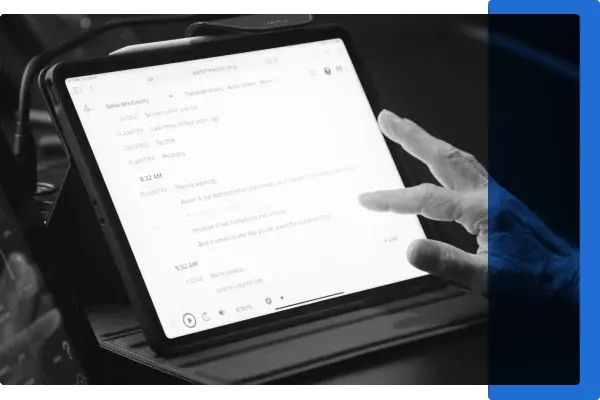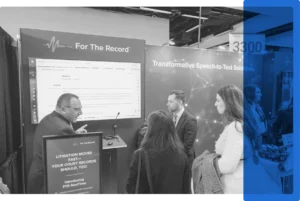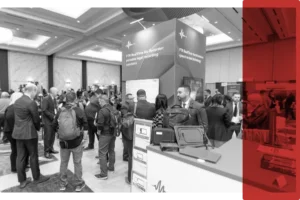
20 Jul
2023
Artificial Intelligence is Reshaping the Legal System and Revolutionizing Access to Justice
In an era marked by technological advancements and transformative breakthroughs, artificial intelligence (AI) continues to reshape various industries, offering new and unique opportunities for growth and efficiency. In recent years, the legal sector—traditionally considered a bastion of tradition—has also been experiencing this digital revolution.
For The Record recently made waves in the news as a key player in the implementation of AI within the justice system.
With our cutting-edge solutions, we are at the forefront of leveraging natural language processing—a branch of AI—to streamline legal processes and enhance courtroom efficiency. The result is advanced speech-to-text technology designed specifically with judicial processes and courtroom operations in mind.
View the recent news coverage from WAVY-TV of For The Record’s role in revolutionizing the legal landscape below.
Transforming courtrooms with AI-powered solutions
One of the key aspects covered in the news broadcast was For The Record’s pioneering efforts in transforming courtrooms through AI-powered solutions. By leveraging AI algorithms and natural language processing, For The Record has developed an innovative tool—FTR RealTime—that transforms the spoken word into text within seconds and delivers a searchable, written record of court proceedings complete with speaker attribution to authorized participants in the courtroom and beyond.
Reducing costs and manual labor
These solutions not only save time and reduce the manual effort required, but also enable legal professionals to focus on other critical aspects of their work. For The Record CEO, Tony Douglass, notes, “The one thing they [court reporters] could never really do is produce repeatable, reliable same-day delivery of transcripts for a lot of courts at a low cost.”
The delays in receiving access to records of legal proceedings are dramatically reduced as rough drafts are delivered instantaneously, meaning judges can review testimony immediately or attorneys can review their trial strategy while in the courtroom.
While it doesn’t produce certified transcripts, the access provided by FTR RealTime can resolve disputes or queries easily, thereby reducing the instances where a certified transcript is necessary—and the significant costs associated. In circumstances where certified transcripts are required, FTR RealTime is a tool that court reporters and transcribers can leverage, ultimately expediting the production process.
Technology already deployed in multiple courts across the country
This innovative technology is already in use in more than a dozen courts across the United States. One of these courts is the Florida Ninth Judicial Circuit in Orlando.
Matt Benefiel, Trial Court Administrator for Florida Ninth, explains the impact this technology will have on the justice system.
“It’s transformational. It’s going to change the industry. And the quality of the speech-to-text has improved so much over the last five years…when you get 92–95% correct, that’s better than what we can do with a human being.”
Nuance in courtroom settings
Court reporter Dana Pon says humans can capture more nuance during legal proceedings, noting, “If someone shakes their head or nods it, I can say that they have nodded their head affirmatively or shook their head negatively.
“I’ve got the ability to have people repeat themselves when someone sneezes or someone coughs. I’m constantly interrupting.”
However, FTR RealTime has been designed with these requirements—and minimal interruptions—specifically in mind.
The strategy and expertise implemented in every courtroom installation and the very nature of FTR RealTime means interruptions to proceedings are drastically reduced. This is a welcome development in a justice system long affected by delays and inefficiencies, ultimately accelerating access to justice.
A core element of FTR RealTime is the linkage of the text with the audio/video recording. If more nuance is required than the draft transcript alone, participants can easily listen to clear audio, review actual footage of the proceeding, or refer to annotations attached to the text. As such, the syncing of the text with the recordings means it’s very easy to validate the accuracy of the speech-to-text output and ensure the tool is useful.
Equipping courtrooms with high-quality recording configuration
Underpinned by best practice audiovisual design, our hardware installations optimize clear communication between parties, capture high quality digital audio and video recordings, and enable efficient and accurate transcription of legal proceedings.
For The Record’s engineers develop advanced software that negates environmental and audio distractions, so every word spoken is captured and readily available for efficient and immediate playback.
Leveraging sophisticated software and hardware configurations, microphones are placed at key locations within the courtroom (judge’s bench, counsel table, gallery, etc.) and each speaker is designated a specific microphone channel.
Channels can be isolated, or the volume can be altered to ensure every word is heard during playback; while FTR RealTime identifies speakers and attributes speech correctly even when participants are cross-talking.
“Knowing who’s talking when in the courtroom and dealing with overtalk is one of the foundational pieces that makes this technology very useful today,” Tony Douglass concluded.
The impact of the court reporter shortage is ongoing
FTR RealTime is already forming part of the solution to the shortage of stenographers in many courts, including the Ninth Judicial Circuit in Florida. The court’s retention and recruitment has improved as resources are reallocated and streamlined, with many court reporters now monitoring multiple FTR RealTime feeds from home.
Professor Fred Lederer, Director of the Center for Legal and Court Technology at William & Mary Law School in Williamsburg, Virginia, noted “We’ll be able to have court records without having to rely on a human being—and we are not having enough court reporters at present.”
For The Record’s commitment to access to justice
As showcased in the recent broadcast, For The Record is driving the reshaping of the legal landscape by filling the gap left by the shortage of stenographers.
Through FTR RealTime, the increase in accuracy and speed at which draft transcripts are produced is already proving invaluable in enhancing the overall efficiency of justice administration, while empowering legal professionals and other participants alike to navigate the complexities of accessing records of legal proceedings.
Read the full story from WKBN First News 27.



